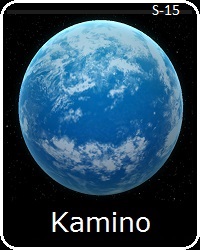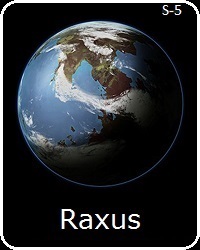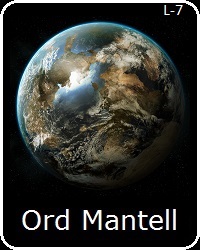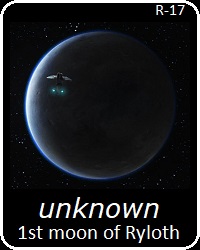

Prior Episodes | 7959 (18 BBY) | Next Episodes
Continuity & Analysis
Star Wars: The Bad Batch - Bounty Lost (2021) [S1E9]
The Batch embark on a rescue mission.
Star Wars: The Bad Batch - Common Ground (2021) [S1E10]
The Batch has their ideology challenged.
Star Wars: The Bad Batch - Devil's Deal (2021) [S1E11]
As the seeds of rebellion foment on an Outer Rim world, the Empire schemes to squash it.
Star Wars: The Bad Batch - Rescue on Ryloth (2021) [S1E12]
The Batch is tasked with a dangerous mission.


CONTINUITY
These four episodes are about the aftermath of the Clone Wars. 'Bounty Lost' is the conclusion to the story which began in
the prior episode, 'Reunion' (S1E8). 'Devil's Deal' and 'Rescue on Ryloth' form a single storyline about Ryloth and the Syndulla
family. The planet Bora Vio and the first moon of Ryloth are seen for the first time. Six worlds are seen in these episodes:






- Lama Su believes Nala Se's "personal interest in the young clone has threatened our operation enough." It had been seen that she is working partly with
the Prime Minister and partly on her own on the subject of Omega, and that she has dispatched Fennic Shand to recover Omega. It is now revealed
that Lama Su has hired Cad Bane. He wishes to have Omega killed after extracting her genetic material, while Nala Se seems to care that she lives.
- Omega has pure, first-generation Jango Fett DNA, and thus is a pure genetic replication, just like Boba Fett, who was apparently originally designated as
Alpha, before being given a name by his genetically-identical 'father' Jango.

Tech states that Boba Fett "disappeared at the start of the war", which is incorrect, while reading information off of his
data device. Why would Boba's history not be in the Republic records which are now Imperial records? The records
should clearly indicate that Boba was involved in the infiltration and destruction of a Republic destroyer while attempting
to assassinate Mace Windu, just over a year after the start of the war. After his arrest, he spent just over a year in
a high-profile Republic prison on Coruscant, as seen in The Clone Wars 'Deception' (S4E15). He is presumed to have
escaped during the major jailbreak seen in that episode, as he was at large and bounty hunting again very soon after
those events. His whereabouts after that point are probably not a matter of record, however both his assassination
attempt and incarceration would be a matter of official record. This could be explained by some convoluted conspiracy
involving the Kaminoans or the Sith erasing evidence of Boba or something, but the most likely explanation is that this is
simply an error. This is surprising considering that writer Matt Michnovetz wrote a number of The Clone Wars
episodes, and even wrote unfinished episodes for that series which would have continued Boba's story after those
events. He therefore knows Boba's history, and chose to gloss over it. This may sometimes work with casual conversation,
however it is a continuity issue when it is being looked up by a character in an official record. It is up to the producers to
notice and prevent such mistakes, usually with the aid of continuity experts. Lucasfilm supposedly employs individuals
to monitor and maintain continuity, however their disney-era SW content often calls that into question.
- Bora Vio is temperate planet located in the Lido Starsystem, which could be considered outside of the galaxy, lying significantly above the galactic
plane in extragalactic space somewhat adjacent to the region of the Outer Rim where Kamino is found. Bora Vio has abundant cloud cover,
suggesting large quantities of liquid water lie below, however its surface has not been seen or described. Its air is breathable, at least in
certain layers of its atmosphere. The Kaminoans established a floating cloning facility in the clouds of Bora Vio at some point within
their memory, but it was abandoned prior to the Clone Wars.


How does Omega's transmitter reach the Batch from Bora Vio? Omega was abducted from Bracca, in the Mid Rim,
and it can be assumed that the Batch had not yet left the general area of Bracca. This places them approximately 25,000
light-years, or 7669 parsecs, from Kamino. It is assumed that Bora Vio is somewhere in the Outer Rim, almost certainly
in the general neighborhood of Kamino, considering their reclusive and isolationist history prior to the Clone Wars.
Even if Bora Vio were located in the well-explored heart of the galaxy near Bracca, it would basically have to be
the neighboring starsystem to Bracca for a small device like Omega's armband communicator to have any chance of
reaching another planet on its own, which would be an absurd coincidence. Numerous examples have established
that a local, planet-based transmitter or relay on a planet is required to reach another planet, or a hyperspace radio
set including those found on ships. The episode has her signal coming through poorly and not allowing a location
trace, but even that is certainly impossible. There would have to be a local transmission tower to link up with for her
message to go out, and only later in the episode does she locate and activate the tower at the Bora Vio facility.
Previous examples of long-range hyperspace messages involving personal communicators were always in situations
where those involved were either receiving messages or were fully interlinked into the larger HoloNet network. Even
if the Batch is still utilizing Imperial HoloNet openly or through a backdoor, her armband is not capable of reaching
the nearest relay satellite or planet-based relay station to link into that network. Rebels established that huge
transmission towers are needed to even reach the nearest starsytem with a message, whereas The Clone Wars
established that even large transmitters in major cities on established worlds have a limited range unless directly
patched into the main network. Ignoring these kinds of limitations for story purposes is a continuity failure.
This is not a definite continuity error only because it cannot be proven that her armband couldn't somehow link up
with the transmitter on Bane's ship, which is unlikely. If so, her first transmission would have been clearly heard.
Main Article: Hyperspace Communications
- Taun We was seen for the first time since Episode II, 13 years earlier, in this series. She is killed on Bora Vio during these events.
- The 'frozen creatures' in cloning tanks which were left by the Kaminoans at the Bora Vio facility are abandoned experiments or cloning projects. Those which
can be seen include what appear to be aliens which are similar to Kaminoans but with much larger heads. It is also possible these particular creatures
are the distorted products of Kaminoan DNA. The Kaminoans were obviously involved in smaller-scale cloning contracts prior to their being hired by
Sifo-Dyas to create the clone army for the Republic, and this may represent work they were doing for some client. If these particular clones are indeed
actually Kaminoans after a fashion, it is likely this was instead an example of some internal Kaminoan project for one of their own, unknown purposes.
- Captain Bragg of the Imperial Army is overseeing the occupation of Raxulon. She wears a four-tile bar insignia with red tiles, indicative of the Imperial Army.
Her rank of Captain is directly given in dialogue, firmly establishing in canon that insignia bars with four tiles of the same color indicate that rank in
any given branch. The rank associated with the insignia of four tiles of one color was not given in dialogue or the credits in the original trilogy, however
decades of supplementary material and legends had established that insignia as a Lieutenant rank, specifically Senior Lieutenant, which was the highest
of four Lieutenant ranks under that system. This change is possible within canon, and does not interfere with any implied or confirmed aspects of
the overall Imperial rank system and insignia. In fact, it is not really a change at all, rather it is confirmation of supplementary material released for
Episode III, which had identified an Imperial Navy officer seen in that film with a blue four-tile bar insignia as being a Captain. This disrupted
the older supplementary material which had associated original trilogy characters wearing the same insignia with the rank of Lieutenant.
Main Article: Ranks and Rank Insignia
- It has now been over a month since Episode III, perhaps as much as two months but probably not much more. The Imperial occupation of former
centers of Separatist authority is proceeding at a calm and measured pace, and even the former capital of Raxus is only now being integrated
into the new Imperial system. The Empire's stated policy is that they "promise to treat all planets within the Confederacy of Independent
Systems fairly" in exchange for loyalty. Senators and other planetary leaders must choose to endorse Imperial occupation and policies or they
will be arrested or killed. As many Separatist worlds naturally offer at least minimal resistance, Imperial procedure is to implement mandatory
curfews, and to deploy the clone army as a military police force.
Main Article: Darth Sidious and The Plan

- The antique vase "gifted to Senator Singh for his years of service" indicates that he was the Senator for Raxus in the Separatist Parliament and had previously
served in the Galactic Senate of the Republic, as the implication is a period of time more than a few years, which would have begun prior to the Clone Wars.
- Cham Syndulla and Gobi Glie were last seen almost 3 years earlier in The Clone Wars 'Liberty on Ryloth' (S1E21) fighting with Twi'lek resistance forces alongside
the clones and the Jedi during the campaign to liberate Ryloth from Separatist occupation. They will both survive until at least 7974 (3 BBY), as they are seen
to be still fighting the Empire with their Free Ryloth Movement 15 years later in Rebels 'Homecoming' (S2E16). Cham's wife Eleni is seen for the first time in
person, but was introduced in dialogue and an image in Rebels. Orn Free Taa was last seen in Episode III, about a month or two earlier.
- At the same time that it is completing the disarmament of former Separatist worlds, the Empire has begun the process of disarming the non-clone forces on loyal
worlds which had fought with the Republic to resist invasion or liberate their world from occupation. The Imperial Army will replace any local forces as
the permanent defence forces for the planet, while mainly intended to serve as a military police force which answered directly to the military government.
This is a violation of the Republic's promise that clone forces would withdraw from planets they were garrisoning once the war had ended. The Empire
can choose to dismiss that as a promise made by a government which no longer exists, and cite its stated priority goal of establishing a new, unified order
in the galaxy for "a safe and secure society." Most of their allies will willingly disarm, and those that don't can be portrayed as Separatists, criminals, or
warmongers who stand in the way of peace. The Sith thus present the threat or reality of death and oppression in the form of the Separatist Alliance,
then introduce their army of clone stormtroopers as saviors and friends. The subsequent Imperial occupation is inevitably portrayed as the means of
securing the peace that was fought for, and necessary to protect newly built Imperial facilities for industry or resource extraction. Thus, each planet
falls under direct administration by the Sith Emperor in a manner which appears to be a natural and logical political, military, and economic progression.
Skeptical Twi'lek fighters on Ryloth have already noted that Imperial troop numbers are increasing despite the outbreak of peace.
Main Article: Darth Sidious and The Plan
- Hera and Chopper make their first appearance chronologically, 13 and a half years before their introduction in the premier episode of Rebels. She is 12 years old
during these events. The Y-Wing which crashed on the Syndulla property almost 3 years earlier during the Clone Wars from which Hera rescued Chopper
is seen, as it will be again seen 16 years later in Rebels 'Hera's Heroes' (S3E5).
- Doonium is some kind of mineral historically used in the construction of buildings, starships, and equipment. The Empire has begun construction and operation
of a refinery on Ryloth to process the doonium extracted from local mines which are being significantly enlarged only months into the new Imperial
regime. This facility is "in the early stages" but the Empire claims that the doonium mine will help to "rebuild parts of the galaxy affected by the war."
This is basically true, although the rebuilding will be according to the designs of the Empire. This statement does suggest that Ryloth is particularly
rich in this useful mineral. These Imperial state-owned facilities are part of the rapidly expanding military-industrial complex, and thus are classed
as economic and military strategic sites, which of course necessitate a heavy military defense. The increase of the peacetime military presence is
justified by the need to protect these military-adjacent industrial facilities, providing the pretext for a larger military and the industry to create it.
- The first moon of Ryloth is one of at least two moons of the planet. Supplementary material has suggested Ryloth has five moons in total. A larger moon,
presumably the second moon of Ryloth, is seen in the sky above the meeting place seen in this episode. The first moon somehow has a breathable
atmosphere, as incredibly unlikely as that is considering it is barren and lifeless, coupled with the unique conditions needed to produce oxygen by
geological processes in sufficient quantity to result in atmospheric oxygen. Most moons of a rocky 'inner' planet like Ryloth would not possess
the necessary size or geological composition to produce this, and due to their size and mass usually have thin atmospheres insufficient for breathing.
Nevertheless, this moon apparently does for some reasons, and is also warm enough to endure with bear skin. This extremely unlikely conditions
would make this moon an ideal location for off-world facilities, however it is unknown if any Twi'lek installations were ever established here.
Main Article: Planetology

- A "comm channel" is the hyperspace communications equivalent of a phone number, which allows transmissions to be routed to a specific reciever. This
must include more than just a specific frequency, otherwise communications traffic in the galaxy would be constantly overlapping over whatever
limited range of frequencies within which signals can be successfully transmitted. This suggests that a "comm channel" includes both an operative
frequency and some sort of unique identifier or routing sequence. This is further evidence that the HyperCom system communicates some sort
of location tracing when a comm system is operating. In other words, the system has to be able to locate the receiver on the Marauder in
real time, in order to successfuly patch in an outside communication. This not only implies that a ship could be located by Imperial authorities
whenever it received a communication, but also that any ship with its radio turned on to receive messages is sending location affirming signals
to the network. This suggests that the Batch is probably using some illegal method to prevent this from being used against them, and also
suggests that anyone who doesn't wish to be found by authorities would routinely rotate their comm channel. This would of course make it
useless to give out one's comm channel to someone who wasn't planning to use it in the near future, since it will soon have to be changed.
Main Article: Hyperspace Communications
- The capitol city of Lessu on Ryloth has scanners which would detect a ship trying to fly there. These may have been standard equipment already in place
and under the control of city administrators, or something installed by the Separatist or Republic occupation. Either way it can be assumed that
most if not all major population centers on any planet usually take stock of the air space in the area and monitor incoming and outgoing craft.
This may not be the case in any location with a decentralized or minimal government, however should be the case in any well-organized system.
Main Article: Scanners, Sensors, and Cloaking Devices
- The Imperial occupation of Ryloth is "similar to that of Raxus", establishing that Imperial policy of occupation is fairly uniform between former Separatist
worlds and 'liberated' Republic worlds which the Empire considers unruly or independent-minded enough to warrant a firm grip.
- Numerous instances of clone disobedience are beginning to be seen despite their most hardcore programming having been triggered only a month or two earlier.
Although this hard reset of their programmed personality had the effect of temporarily overriding the unique personalities they had developed, many
strong-willed clones have begun to revert to their prior selves, as if the override over their sense of right and wrong has worn off. This will increase to
some extent, and will require the Empire to begin decommissioning many of the older clones, or those with unusually defiant or ethical outlooks.
- The Free Ryloth Movement against the Imperial occupation is formed by a faction of the Ryloth Resistance, which had been formed during the Separatist invasion
of Ryloth 3 and a half years prior. It will survive to resist for at least another 16 years, when it is seen to be an independent associate of the Rebel Alliance.
ANALYSIS
The Empire is still implementing the full-scale occupation of core Separatist systems a month or two after the end of the Clone Wars, having spent some time
consolidating their positions and crushing scattered and disorganized hold-outs which refused to accept the surrender. The implementation of direct occupation
of tens of thousands of Separatist worlds could not be accomplished instantly due to troop and resource limitations, as well as the political concerns of each
major planet which require a bit of tact to handle correctly. Separatist leaders are often allowed to keep their positions at first, to facilitate the orderly transition
into the new political regime, provided that they willingly act as enthusiastic supporters for Imperial policy. Leaders who refuse to cooperate are arrested for their
treason against the Republic, which is now the Empire, however Imperial policy is to present themselves as an uninvolved third-party which is stepping in to
restore order, while officially not taking sides regarding Republic or Separatist worlds. This obviates some of the feeling of being conquered on Separatist worlds,
while also presenting a false sense of civil society and fairness which will cause obstinate Separatists and resistant citizens to expose themselves as opposed to
the Empire. The Emperor tests the rebelliousness and independence of his new subject populations the same way the Clone Wars were used to test the various
worlds of the galaxy for the same qualities. The Clone Wars allowed Sidious to unite such planets into the Separatist Alliance, insuring their destruction or
occupation, or sometimes both. The Imperial occupations of these worlds will now use an overbearing and obtrusive military presence, mandatory curfews,
and citizen registration methods like chain codes to instigate these same populations which willingly stood against the Republic, in order to draw out the most
troublesome elements which remain in these societies. The full integration of Separatist starsystems will take years or even decades of careful work. In the interim,
the Empire need only establish its overarching authority, and carefully weed out resistance in the name of law and order. Political and economic changes will
come gradually, and only after the orderly transition of power structures on a planet has been seen through, requiring patience and strategy on the Empire's part.

The Imperial troop presence on Ryloth is "similar to that of Raxus", further evidence of the Empire's 'even-handed' policy towards former Republic and Separatist
worlds. This policy significantly aids the reintegration of Confederate planets into the galactic state, however it is resented by independent-minded worlds which
were allies of the Republic out of policy or necessity. Republic and neutral worlds which received this treatment included sovereignty-inclined homeworlds of
non-Human races, worlds with a strong martial tradition which raised significant local forces during the war, and worlds considered too inclined towards
democracy to accept the authoritarian adjustments to the political system under the Empire. Ryloth meets all of these criteria, and thus is treated to a full-scale
military occupation. Imperial procedure is to round up troublesome but peaceful citizens, hoping that it will inevitably incite an uprising. Those who participate
in such actions are then killed or arrested. The Empire and its supporters consider that forcing populations into submission by attrition is the "cost" of peace.
The Republic/Empire's policy towards Ryloth and other 'liberated' worlds was always geared towards establishing direct control over the long term. Imperious
states which 'liberate' smaller states in wars only to integrate them into their own political sphere is a common pattern in history. Ryloth's Twi'lek population with
their French accents are meant as an illusion to France or western Europe during WWII. They eventually resisted Germany, in this case the Separatists, largely
due to the aid of the United States and its large military. After the war, the U.S. remained in Europe, turning its army into an occupation force which it claimed
was there to help rebuild and insure security. The inevitable rebuilding came at great benefit to U.S. industry, and the occupation and maintenance of a huge
military force was a boon to the U.S. military-industrial complex. Imperial states like the U.S. and many others throughout history repeat the same process to
gain control of both friendly and enemy states. They first move in as liberators or as a 'civilizing' force, establish bases, use their wealth and position to control
the politics, gain ever-increasing levels of economic influence, extract resources, and most importantly refuse to leave. An Empire need only to establish its
permanent presence during the early stages of this process, beginning by establishing strategically vital installations like mines and factories, and then setting up
military outposts and logistics for their defense and maintenance. These moves insert significant Imperial enterprises into the local economy without immediately
usurping any local industry. This allows the Empire to begin its program of organized and forced labor by presenting it as an honest means of bringing jobs to
the masses of unemployed or struggling workers. Any economic entities which survived the Clone Wars and the rise of Imperial state industry will eventually
be nationalized or quashed, however at this early stage of the Empire such moves are unnecessary and would only serve to accelerate disdain for the Imperial
system and resistance to it. Over time, the policies of whatever Empire-friendly government rules on Ryloth will be subsumed to the needs and interests of
the Empire, its vast war machine, and the military-industrial complex which profits from occupation, effectively undermining Ryloth's sovereign interests.

The Sith launched the Separatist invasion of Ryloth to kill and enslave the population while destroying the planet's infrastructure, which if successful would have been
a happy result for them, all the while knowing that the Republic would likely retake the world at some point. This resulted in a Republic occupation of Ryloth, which was
accepted by the Jedi leadership as necessary for security, welcomed by the majority of Twi'leks for the same reason, and seen by any observers as both a strategic wise
military precaution and a legitimate policy. These forces will have earned the trust of a majority on most worlds which received this treatment during the Clone Wars,
and just as the clones earned the trust of the Jedi before being turned against them, this will succeed in fooling many into giving up their arms only to have the Empire
turn the clones against them as an armed occupation. The only problem with this plan was that the clones had to be honorable to earn that trust in the first place.
This quality would reassert itself in many clones, despite their programming and control chips, leading to disobedience regarding the Empire's duplicity and policy
towards the world's and people they had come to respect and care about. This would prove a minor issue for the Empire in its attempts at a seamless transition to
a new order, however the majority of clones would not take a stand against their leaders. Additionally, war weariness was a significant factor in the Empire's favor,
just as Sidious had intended. After years of war, economic depression, death, and uncertainty, most of the citizens of the galaxy are eager for a period of stability and
peace. Even those with good reason to oppose the Empire at this early stage are unlikely to find enough allies for another conflict, at least in the immediate future.

The political rivalry between the corrupt but relatively innocuous Senator Orn Free Taa and planetary hero General Cham Syndulla which had somewhat disrupted
Twi'lek unity during the Separatist occupation continued to divide Ryloth's leadership, making it far easier for the Empire to manipulate the planet. This was largely
because Senator Taa, predictably, cared more about his political influence than Ryloth's interests, while Cham made every effort to attempt to be cooperative,
despite his strong opposition to any long-term Republic presence only 3 years prior. Orn Free Taa is not nefarious enough to willingly undermine his planet's interests,
however he is primarily concerned with selfish politicking, and can't see the threat because he believes he is an Imperial authority and on the inside, and doesn't
realize that the Empire's friends are disposable pawns. As a result, Taa still cannot see beyond Syndulla's popularity, and while the old fight continues, the Empire
uses them against each other while carefully but rapidly establishing their grip over the planet. The Empire is disposing of threats whether they cooperate or not,
and Syndulla and his allies have been identified as a significant threat. Syndulla's cooperation, despite the Empire's refusal to honor the Republic's promise to leave
the planet, is therefore an impediment, but one that is easily dealt with by pushing him until the Empire crosses a line which will lead him to take a stand against
them. In order to move events along, the Empire shoots Senator Taa and blames Syndulla, a typical tactic for leaders of manipulative imperial governments.
Politics is as much about theatrics as it is about the reality of events, and an amoral government can always use assassins, agent provocateurs, and false flag
operations to instigate or provide pretext for major policy shifts, political unrest, revolutions, and wars. An empire's faithful allies are often sacrificed for such goals.

FURTHER ANALYSIS
Report Pending